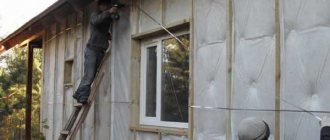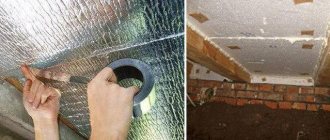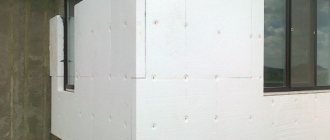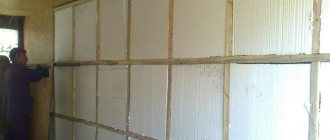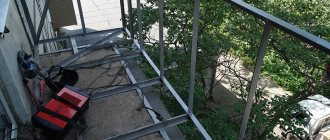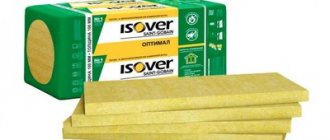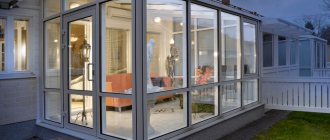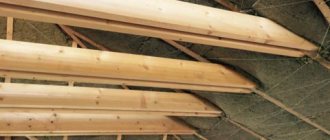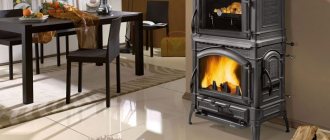Insulation
05/11/201608/19/2016 balkoninfoLeave a reply
The cold season, or rather winter, dictates precise rules for protecting our houses and apartments. By taking certain measures to insulate some of the rooms, you can avoid quite large heat losses, while creating coziness and usable space for comfortable living. In this article we will look at insulating a balcony with foam plastic with our own hands.
It is not so easy to choose insulation for a balcony, and especially to choose it from the many materials offered. There are many suitable insulators on the building materials market. But how to choose an inexpensive and, most importantly, easy-to-use product? You can start with an inexpensive material - polystyrene foam.
Polystyrene foam is a pretty good insulator, easy to cut with a knife, and an excellent sound insulator. It is easily attached to surfaces, and can be used either for finishing with plastic or gypsum boards, or can serve as an independent load-bearing fabric. An additional plus: good value for money of this material.
The difference between polystyrene foam and polystyrene foam
Polystyrene foam is less dense than expanded polystyrene.
The materials are similar to each other in that expanded polystyrene and polystyrene foam have a polystyrene foam base and are made from polystyrene, but using different technologies.
To make polystyrene foam, polystyrene is steamed under water steam in special molds, and the polystyrene granules are baked to each other, increasing in size. Polystyrene foam has a lower density than polystyrene foam and tends to crumble when the bond between the granules weakens.
Expanded polystyrene is made by extruding polystyrene, it is melted, a foaming composition (soft, hard freon or a freon-free hydrogen-based composition) is introduced into it under pressure, and passed through an extrusion machine.
The output is strong polystyrene foam, consisting of dense cells filled with air. Available with a smooth and stepped edge with a regular and foil surface.
The most environmentally friendly are hydrogen-based foaming compounds without the addition of freon, which tends to destroy the ozone layer.
Choice of insulation
Although external insulation involves cladding work, even the inner layer must have minimal moisture-resistant properties. Builders do not recommend using mineral wool - it can swell from moisture and crumble heavily during installation.
You can choose foam in a balloon as an insulating layer. It is applied along the entire parapet, and not just filling the cracks. The foam adheres well to any surface and creates a voluminous layer. But it is destroyed under the influence of ultraviolet radiation and turns yellow, so it requires quick lining. Complete foaming of a large balcony is a bit expensive.
Sometimes insulation is carried out using sandwich panels, but they are too heavy - it is difficult to carry out work at heights.
The most commonly used material is polystyrene foam due to its low cost and light weight. It is easy to cut, practically does not crumble and is quite moisture resistant. Penoplex, which has similar qualities, is a little stronger.
Due to the flow around the metal frame, polyurethane foam provides maximum thermal protection, but the insulation itself, and working with it, is not cheap.
Corrugated sheeting, siding, cellular polycarbonate or other moisture-resistant sheet materials are chosen as cladding for the balcony. Sometimes the plastering method is used.
Advantages of expanded polystyrene
Extruded polystyrene foam is the best option for insulating a balcony and has a number of advantages:
- durable, sufficiently resistant to mechanical stress material;
- has a solid structure and does not crumble;
- does not collapse due to temperature changes, can be used in the range from -50 to + 75 degrees;
- ecologically pure;
- does not lose its qualities when exposed to high humidity;
- the material is not subject to rotting processes;
- has high thermal insulation and sound insulation properties;
- It is light in weight, which is important when insulating a balcony;
- durability 50 years;
- quite low cost.
Preparing for work
Immediately before the insulation process itself, it is necessary to clear the balcony of unnecessary objects, inspect the surface of the walls and parapet, and, if necessary, carry out related work. It is necessary to get rid of the old coating, strengthen the cracked areas of the walls and floor, and also cover up all the holes and other surface defects remaining after dismantling.
After the walls have been repaired and the glazing has been checked for tightness (on an unglazed balcony the need for insulation disappears by itself), you can proceed directly to the surface preparation itself.
Flaws
Expanded polystyrene is a flammable material.
The disadvantages are flammability, but with the property of self-extinguishing (the material can catch fire, but does not support combustion).
The surface of expanded polystyrene is destroyed when exposed to ultraviolet radiation, contact with coal resin, paint thinners, and polyvinyl chloride.
When insulating a balcony or loggia with polystyrene foam, it is necessary to cover it on top with finishing material: clapboard, MDF panels, etc. We use glue suitable for working with this material.
Common Mistakes
It is important to know not only how to properly insulate a loggia, but also what not to do. No one is immune from mistakes, but recommendations will help prevent them.
Placing central heating radiators on a balcony or loggia
Such actions will be detected sooner or later and the system will have to be removed. In addition, this is unsafe - the radiators are included in a common network, redevelopment of which can cause serious disruption. Plus there is a fine for this.
Removing a door or window block from an apartment to a balcony
From a legal point of view, this is a redevelopment that requires permission. It follows that in some cases this permission can be legally obtained.
Blind repetition of stories from television programs about repairs
In such programs, a balcony and a room are often combined. Regulatory authorities may recognize this as a violation: for example, for deteriorating heat supply to neighboring apartments. Then dismantling and payment of a large fine will be required.
Frameless glazing
Visually it looks very interesting. But for insulation you need double and triple PVC windows.
What to look for when choosing a material
The heat-saving characteristics are affected by the density of the material. The thicker the sheet we choose, the more area it will take up. With a sheet density of 25 kg per cubic meter, a sheet 80 mm thick will be sufficient.
If the density of the extruded material is higher, then a sheet with a thickness of 50 mm can be used.
When choosing a material, pay attention to:
- all slabs are of the same thickness, width, length;
- granules of the same size, evenly distributed;
- no foreign odor;
- packages are marked;
When using polyurethane foam, we take into account that toluene, which is sometimes included in its composition, dissolves polystyrene foam.
Insulation with mineral wool
Unlike rigid insulation, mineral wool is placed between the joists so that it fits tightly and comes into contact with the beams. However, you should not use slabs of such sizes that the material would have to be compacted, as this will lead to swelling of the mineral wool. As a result, the structure of the insulation will be damaged, which will negatively affect the thermal insulation characteristics of the material.
Mineral wool is also covered with a vapor barrier film, but before installing the decorative cladding, it is necessary to fill the counter-lattice
This is a mandatory precaution that will prevent the insulation from coming into contact with the cladding and will prevent a shift in the dew point
Methods for insulating a balcony
Insulation is carried out using the adhesive and frame method.
Glue method
Even an inexperienced craftsman can glue polystyrene foam.
Even a person without construction skills can cope with such work. We treat the surface with adhesive suitable for working with polystyrene foam, glue the insulation, and additionally fix it with self-tapping screws.
A fiberglass reinforcing mesh is attached to the glue on top, then plastered or covered with the selected finishing material.
Frame method
Installation is more complex than insulation using the adhesive method. Preliminary installation of a frame made of wooden beams or metal profiles is required.
The insulation is fixed between the frame so that there is no space left between the frame elements and the polystyrene foam.
We choose insulation of the same thickness as that of the frame slats.
How to insulate a balcony with foam plastic
The walls, upper and lower balcony slabs, that is, the ceiling and floor, are subject to insulation. Everyone chooses the order of work at their own discretion. It is impossible to leave any one uninsulated object. There will be no sense from the work carried out.
This video will help you better insulate your balcony with polystyrene foam:
How to insulate floors and walls on a balcony with polystyrene foam
Several technologies for laying polystyrene foam are known. All of them are equally applicable to walls, ceilings and floors. There are only a few nuances associated with subsequent finishing.
The step-by-step insulation of a balcony with polystyrene foam looks like this. Using wet facade technology, the slabs are glued to the wall. Use a special adhesive mixture or foam from cylinders. Each sheet is fixed with umbrella dowels. Place 5 of them: 1 in the center and in each corner.
Using wet facade technology, foam is glued and plaster is stretched on top
The joints between the plates are sealed with foam. After gluing the entire wall, a reinforced mesh is attached to the foam plastic surface with an adhesive solution, and plaster is stretched on top.
Using this technology, slabs are glued to the floor in a similar way, only instead of plaster, a different finish is used. Usually a concrete screed is poured on top of the insulation. Since foam plastic does not withstand mechanical loads well, a metal reinforcing mesh is embedded inside the screed. The concrete thickness is poured at least 4 cm.
If there is no desire to tinker with the concrete screed, chipboards or plywood are laid on top of the insulation. After the rough flooring, they begin installing the finishing coating.
The gaps between the sheathing and the insulation are sealed with foam
Using dry façade technology, sheathing is attached to the balcony walls using slats. Insulation occurs by laying slabs inside cells. The gaps between the sheathing and polystyrene foam are filled with foam. For better heat reflection, foamed polyethylene with a foil coating is attached. The mirror side is directed inside the balcony. After insulating all sections of the wall, the lining is attached to the sheathing. You can sew it up with plywood or plasterboard and stick wallpaper.
On the floor using dry facade technology, foam is laid between the joists
Floor insulation using dry facade technology occurs in a similar way, only the role of the lathing here is played by logs. The timber is secured with anchors or dowels to the balcony slab. Expanded polystyrene is placed between the joists and the cracks are blown with foam. A finished floor made of boards, particle boards or plywood is laid on top of the logs.
How to properly insulate a balcony ceiling with foam plastic
Similar actions are performed with the ceiling surface. You can create a sheathing or simply glue the slabs without it. In the first case, lining is sewn over the sheathing, but most often they give preference to plasterboard. The sheathing is puttied, sanded, and painted with water-based paint.
The plasterboard sheathing on the ceiling after puttying is painted with water-based paint
If the insulation is carried out using wet facade technology, then the plaster is stretched exactly as on the walls. Finishing usually also involves painting. If desired, glue wallpaper or plastic panels.
Materials and tools for insulating a balcony
Before starting work on insulating the ceiling and walls, it is necessary to prepare tools and prepare materials. We calculate the area of the room, purchase the material with a reserve of 10-20%.
You will need:
- Extruded polystyrene foam, preferably with a stepped edge, so that the sheets fit better together;
- Vapor barrier material (foiled polyethylene foam penofol or dense polyethylene film);
- Special adhesive for polystyrene foam;
- Polyurethane foam that does not contain toluene;
- Wood beams or metal profiles for installation of sheathing;
- Plastic dowels with disc head;
- Scotch;
- Construction level, stationery knife;
- Drill, hammer drill, screwdriver, stapler, electric jigsaw, grinder.
conclusions
Insulating your balcony yourself has its advantages. One of them is that the owner can determine the desired method of insulation independently. In addition, installation work can be done at any time, whenever it is convenient, without waiting for the technicians to arrive and complete the installation. When using polystyrene foam, no special skills are required. Even a non-professional can cope with its installation. The main thing is to strictly follow the instructions, according to which everything is done very easily, and not give up.
Do-it-yourself insulation of a balcony with polystyrene foam
Insulation of a loggia or balcony with polystyrene foam can be easily done with your own hands. Before starting work on insulating the loggia, we install the balcony frame and prepare the surfaces that will be insulated.
Surface preparation
Adhesive for expanded polystyrene
Before insulating a balcony or loggia with expanded polystyrene, it is necessary to repair and prepare all surfaces. Only after this should we begin insulating the loggia with polystyrene foam.
Preparation stages:
- We carefully inspect all surfaces for smudges and yellow-brown spots.
- We remove the swollen, peeling layer of building materials.
- We treat the surface with an antifungal compound and prime it to increase its strength.
- If the balcony is leaking, we find even the most microscopic cracks and fill them with polyurethane sealant.
- If the cracks are large, we widen them with a grinder, look at the condition of the reinforcement, remove rust from it, and cover it with an anti-corrosion compound. We wet the cracks (for better adhesion with foam), fill them with polyurethane foam, when the foam dries, cover them with sealant.
- If desired, you can align the walls and ceiling. If the surface is not leveled, the finishing will hide all defects.
For insulation, you can use types of polystyrene foam:
- Styrofoam;
- penoplex;
- foil polystyrene foam.
Sheathing the ceiling
We begin insulation work from the ceiling. The optimal thickness of the insulation sheet for finishing with clapboard or plastic is 50 mm with a density of 15 kg per square centimeter. Under the putty, insulation with a density of 25 kg per square centimeter is used. On the top floor, you can perform external insulation of the top slab and insert insulation under the roofing material.
Stages of indoor work:
- We mark the locations of the fasteners, install hangers for fastening metal profiles (when installing wooden sheathing, mark the installation locations of the sheathing).
- We treat the surface with a special glue, in a dotted manner, and apply a strip of glue along the edges of the sheet. We glue the insulation, pressing it tightly, hold it for several minutes, and strengthen it with self-tapping screws.
- If plaster is to be applied on top, after the glue has hardened under the polystyrene foam, glue the reinforcing mesh onto it.
- If the finishing is done with wooden lining, plastic or MDF panels, we attach a vapor barrier layer to the foam plastic.
Materials with a foil surface have good quality characteristics; they simultaneously have thermal insulation and vapor barrier properties, and are attached with the foil side facing out.
Wall insulation
Following the ceiling, we insulate the walls. The internal wall that adjoins the room does not need to be insulated. But if you insulate, then the room will be warmer, and if you do not insulate, then the heat from the radiator in the room will pass to the balcony, and it will be warmer on the balcony. For more information about insulating walls with polystyrene foam, see this video:
We insulate the walls according to the same scheme as the ceiling; we begin to attach the sheets from the bottom level. These works are performed easier and faster due to the fact that the work is not done at height.
We lay the insulation tightly to each other; if a gap has formed between the sheets, blow it out with foam. We cut the outer slabs to the required size with a stationery knife. If the sheets do not fit together in the corners, fill the gap with foam. The last step is to insulate the window slope.
The best option for a vapor barrier material is penofol on an adhesive base, with a top foil layer. The edges of the penofol are glued end to end and insulated with foil tape. If penofol does not have an adhesive base, it is secured with special glue.
We attach the outer trim at a distance of 20 mm from the foam foam to form an air gap between the materials. This distance is optimal for the foil layer to reflect heat into the room.
Floor insulation
We lay expanded polystyrene on a concrete screed or between wooden joists, polystyrene foam only between wooden joists. Before insulation, it is necessary to repair the balcony slab; it can be preventive or major, depending on the degree of its destruction. For more information about floor insulation, watch this useful video:
The floor of the balcony should be either at the same level as the floor of the room, or lower.
Stages of work:
- We remove the old covering from the floor, remove all loose, swollen building materials, and remove dust using a vacuum cleaner.
- We inspect the slab. After treating all the cracks (with cement mortar, tile adhesive, sealant), we prime the surface to increase its strength and proceed to insulation.
Insulation using concrete screed
We level the floor using a screed, wait until the screed is completely dry, this can take up to several weeks, depending on the temperature and humidity in the room. On the screed that has dried to the ground, we cover it with a waterproofing layer, lay polystyrene foam on top of it, and a vapor barrier layer.
Then fill the thin screed with a self-leveling mixture or lay an OSB board. We lay the finishing coating on top. This can be laminate (you need to lay a backing underneath), linoleum, parquet, ceramic tiles. For more information about concrete screed, watch this video:
Floor insulation using joists
Wooden logs are attached strictly level to the prepared surface of the slab, and polystyrene foam is laid between them so that there is no gap left at the edges.
All gaps between the floor elements are filled with foam, without toluene in the composition, vapor barrier material, OSB board, floor covering are laid: floorboard, laminate, parquet, linoleum.
Using wooden joists you can raise the floor to the required height.
By insulating the floor, ceiling and walls on the balcony, you can turn it into a full-fledged living space and get a cozy corner for relaxation.
What is the best way to insulate: TOP 5 materials
The range of building materials allows you to find insulation materials that correspond to the climatic conditions of the region and the selected heating system. The main technical characteristics in this case are heat transfer coefficient, resistance to mechanical action and waterproofness.
Expanded polystyrene (foam)
The most popular material for insulating balconies. Typically, sheet foam is used with a thickness of 5 cm, or, in harsh climates, 10 cm.
Advantages:
- low thermal conductivity coefficient – i.e. high thermal insulation even without additional materials;
- satisfactory strength - dense finishing materials can be used;
- high moisture absorption rate - there is no need for an extra layer of waterproofing;
- environmentally friendly and hygienic - does not emit hazardous substances, mold will not develop, and dust does not form during operation;
- ease of installation - sheet foam is easily cut into pieces;
- long service life - up to 30 years (subject to technology).
Flaws:
- poor air conductivity - additional ventilation methods are needed;
- low noise insulation;
- poor resistance to chemicals based on alcohol and petroleum products, as well as some varnishes and drying oils;
- high flammability.
Insulation of the walls of a loggia or balcony is carried out with construction foam with a density of 35–40 kg/m³. It is easy to distinguish it from packaging by its polygonal cells.
Extruded polystyrene foam (penoplex)
The disadvantage of extruded polystyrene foam is its high cost.
There are several types of material on the market (according to their intended purpose):
- “Foundation” - for insulating structures buried in the ground.
- “Roofing” - for finishing attic spaces, it is fragile.
- “Wall” - for cladding external walls and partitions above ground level.
- “Comfort” - for insulating loggias and balconies (balanced view).
Typically, penoplex sheets are fastened with polyurethane foam or “liquid nails.”
This material is an improved version of conventional foam - lower thermal conductivity due to its uniform porous structure.
Other differences of penoplex include lower fire hazard and greater strength - it can even be laid on the floor. Otherwise, the advantages of the materials are the same.
Mineral wool
For insulating a balcony, basalt mineral wool is better suited - the most environmentally friendly type of material with excellent technical characteristics.
Characteristics of foam plastic
Polystyrene foam is a foamed plastic mass that, after hardening, acquires a cellular structure. Improvements in production technology have increased the resistance of the material to aggressive chemicals, and also lowered the flammability class to the “self-extinguishing” level.
Foam plastic has the following technical characteristics:
- Density - 8-40 kg/m³.
- The volume of absorbed moisture when the slab is completely immersed in water for 24 hours is 2-4%.
- Thermal conductivity coefficient is 0.037-0.043 W/(m×°K).
- Compressive strength under deforming influence - 10% (0.04-0.16 MPa).

